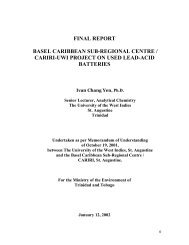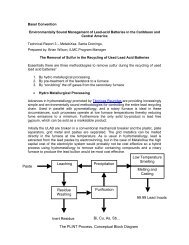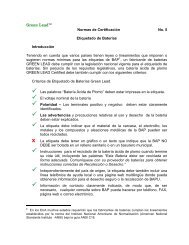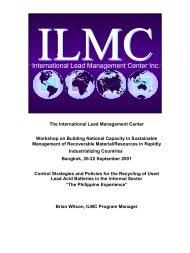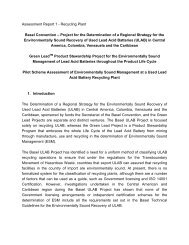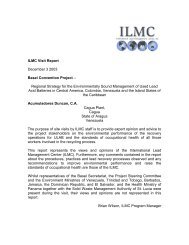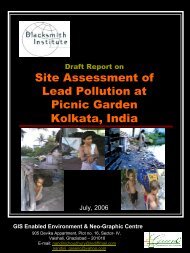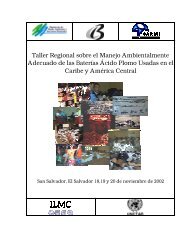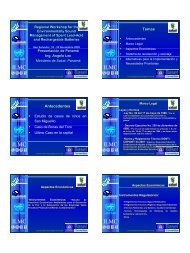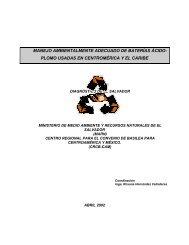Rpublique du Sngal - the International Lead Management Center Site
Rpublique du Sngal - the International Lead Management Center Site
Rpublique du Sngal - the International Lead Management Center Site
Create successful ePaper yourself
Turn your PDF publications into a flip-book with our unique Google optimized e-Paper software.
United Nations Common Fund for Commodities<br />
and<br />
The <strong>International</strong> <strong>Lead</strong> Zinc Study Group<br />
Technical expert mission in Senegal to Finalize Plans to set up a Collection<br />
<strong>Center</strong> for Used <strong>Lead</strong> Acid Batteries in Dakar consistent with <strong>the</strong> Basel<br />
Convention Technical Guidelines and to Integrate <strong>the</strong> activities of <strong>the</strong> <strong>Center</strong><br />
with Domestic Recovery of <strong>the</strong> Used Batteries in a manner that is<br />
Environmentally Sound<br />
Dakar, Senegal, 28 – 31 March 2010<br />
Report prepared for <strong>the</strong> <strong>International</strong> <strong>Lead</strong> Zinc Study Group<br />
(June 2010)<br />
Brian Wilson<br />
<strong>International</strong> <strong>Lead</strong> <strong>Management</strong> Centre<br />
0
1. Intro<strong>du</strong>ction<br />
On 15 April 2008, <strong>the</strong> Ministry of <strong>the</strong> Environment and Natural Resources in Senegal<br />
made an official request for technical assistance to <strong>the</strong> Secretariat of <strong>the</strong> Basel<br />
Convention (SBC) concerning a case of contamination of local populations, mainly<br />
women and children, from hazardous waste <strong>du</strong>e to lead recovery activities in <strong>the</strong><br />
informal sector from used lead acid batteries. The communication to <strong>the</strong> secretariat<br />
mentioned <strong>the</strong> death of at least eighteen babies and young children <strong>du</strong>e to lead<br />
poisoning and <strong>the</strong> likeliness of <strong>the</strong> contamination from lead of many indivi<strong>du</strong>als,<br />
including a<strong>du</strong>lts.<br />
Assistance was requested with a view to reviewing <strong>the</strong> situation at Thiaroye sur Mer<br />
and ascertaining what actions needed to be considered locally and nationally, in <strong>the</strong><br />
short-term and <strong>the</strong> longer term, to prevent fur<strong>the</strong>r contamination from lead of local<br />
populations and assist in developing a national plan for <strong>the</strong> environmentally sound<br />
management of used lead acid batteries in <strong>the</strong> context of <strong>the</strong> implementation of <strong>the</strong><br />
Basel Convention. The mission of an expert from <strong>the</strong> <strong>International</strong> <strong>Lead</strong> <strong>Management</strong><br />
Centre took place from 21 to 27 April 2008 in Dakar, Senegal. The mission has lead<br />
to fur<strong>the</strong>r consultations with <strong>the</strong> WHO Headquarters in Geneva and <strong>the</strong> UNEP-OCHA<br />
office in Geneva.<br />
A report of <strong>the</strong> emergency measures taken by <strong>the</strong> Government in March 2008 was<br />
transmitted to <strong>the</strong> secretariat and <strong>the</strong> expert prior to <strong>the</strong> mission. After meetings with<br />
<strong>the</strong> local population to explain <strong>the</strong> course of action <strong>the</strong> Government intended to take,<br />
<strong>the</strong> Ministry of <strong>the</strong> Environment and Natural Resources coordinated <strong>the</strong> removal of<br />
three hundred tons of leaded and battery waste from <strong>the</strong> site Thiaroye sur Mer<br />
between March 8 th and 13 th . The priority for <strong>the</strong> removal of <strong>the</strong> contaminated soil<br />
was from <strong>the</strong> areas close to <strong>the</strong> homes of <strong>the</strong> families engaged in <strong>the</strong> informal ULAB<br />
recovery operations. All informal ULAB recovery operations at <strong>the</strong> site were stopped<br />
and nearly 300 tons of <strong>the</strong> lead contaminated soil from Thiaroye sur Mer taken to <strong>the</strong><br />
Pagrik Senegal Company, a recently opened ULAB recycling plant to be stored<br />
under cover in lieu of treatment to render <strong>the</strong> soil lead free. The lead contaminated<br />
soil removed from Thiaroye sur Mer was replaced with lead free sand to a depth of<br />
approximately 14 cm.<br />
The Environment Ministry moved <strong>the</strong> contaminated soil to be stored at <strong>the</strong> Pagrik<br />
Senegal yard because <strong>the</strong>y believe that <strong>the</strong> company can process and treat <strong>the</strong><br />
contaminated soil in an environmentally sound manner to remove enough lead to<br />
render it safe for disposal in a domestic waste <strong>du</strong>mp, or for use as infill material.<br />
Priority at Thiaroye sur Mer was given for <strong>the</strong> removal of soil in front of <strong>the</strong> houses of<br />
<strong>the</strong> families engaged in <strong>the</strong> informal recycling and <strong>the</strong> area most used to break open<br />
<strong>the</strong> batteries. Never<strong>the</strong>less, <strong>the</strong> Environment and Health Ministries are not certain of<br />
<strong>the</strong> extent of <strong>the</strong> lead contamination at Thiaroye sur Mer, but do believe that <strong>the</strong>re is<br />
still a lot of soil in and around <strong>the</strong> Thiaroye sur Mer site that is contaminated with lead<br />
and battery acid, which will require more remediation work.<br />
1
The activities in Senegal of <strong>the</strong> Blacksmith Institute 1 were taken into consideration as<br />
<strong>the</strong> organization was in <strong>the</strong> process of con<strong>du</strong>cting an independent survey of<br />
“informal” ULAB recovery operations in and around <strong>the</strong> city of Dakar. Corroborating<br />
material from <strong>the</strong>ir preliminary surveys was sought and transmitted prior to <strong>the</strong><br />
mission to <strong>the</strong> Secretariat confirming that five “Informal” ULAB recovery sites had<br />
been located by <strong>the</strong> Blacksmith Institute in <strong>the</strong> Dakar area. Thiaroye sur Mer was not<br />
<strong>the</strong> only location for informal ULAB recovery operations. Also, it was made known to<br />
<strong>the</strong> secretariat that <strong>the</strong> Blacksmith Institute had decided to follow up to its preliminary<br />
investigation with site visits, including Thiaroye sur Mer, because of its focus on<br />
remediation of toxic sites and community engagement.<br />
In January 2009 <strong>the</strong> <strong>International</strong> <strong>Lead</strong> Zinc Study Group, responding to <strong>the</strong> call for<br />
assistance to resolve <strong>the</strong> <strong>Lead</strong> exposure issues at Thiaroye sur Mer and set up a<br />
formal used lead acid battery collection center in Dakar submitted a Project Proposal<br />
to <strong>the</strong> UN Common Fund for Commodities (CFC) for a $120,000 award to implement<br />
such a scheme. Approval for funding this Project was awarded in June 2009. The<br />
Implementing agency for <strong>the</strong> Project is <strong>the</strong> <strong>International</strong> <strong>Lead</strong> <strong>Management</strong> <strong>Center</strong><br />
(ILMC).<br />
The primary objective of this project is to establish a ULAB collection center in Dakar<br />
to source, pack and prepare for <strong>the</strong> transport of ULAB to a recycling plant that is<br />
environmentally sound and complies with <strong>the</strong> environmental, safety and health<br />
legislation of Senegal and conforms to <strong>the</strong> Basel Technical Guidelines for <strong>the</strong><br />
Recovery of ULAB. At <strong>the</strong> time of <strong>the</strong> mission <strong>the</strong> ILMC was working in liaison with<br />
<strong>the</strong> Government of Senegal and Pagrik Senegal to confirm <strong>the</strong> environmental<br />
credibility of <strong>the</strong> Pagrik Recycling Plant at Sebikotane, a site approximately 45<br />
kilometers to <strong>the</strong> East of Dakar.<br />
ULAB are classified as hazardous waste under <strong>the</strong> Basel Convention and must<br />
treated as such when arrangements are made to transport <strong>the</strong>m to a recycler. The<br />
main risk <strong>du</strong>ring transport is associated with <strong>the</strong> battery electrolyte that may leak from<br />
ULAB in transit.<br />
Achieving <strong>the</strong> objective of setting up a collection center in Dakar (TSM is an option):<br />
• Re<strong>du</strong>ce considerably <strong>the</strong> health risks to <strong>the</strong> local population caused by <strong>Lead</strong><br />
exposure<br />
• Re<strong>du</strong>ce and possibly eliminate <strong>the</strong> environmentally unsound recovery of ULAB<br />
• Provide a source of revenue from <strong>the</strong> servicing of <strong>Lead</strong> Acid Batteries (LAB)<br />
and <strong>the</strong> collection and sale of ULAB<br />
• Provide employment at <strong>the</strong> <strong>Center</strong> and work for <strong>the</strong> local population as LAB<br />
testers, service technicians and ULAB collectors<br />
• Improve public awareness of <strong>the</strong> proper handling and disposal of ULAB<br />
• Create a local partnership with <strong>the</strong> Pagrik Senegal SA Recycling Plant<br />
• Provide a model for o<strong>the</strong>r ULAB collection centers in Dakar and Senegal<br />
This project aims to be sustainable, replicable, cost effective and manageable.<br />
1 Blacksmith Institute – Hhttp://www.blacksmithinstitute.org/H - An institute based in <strong>the</strong> USA that<br />
specializes in providing remediation support especially in <strong>the</strong> field of lead exposure.<br />
2
Close liaison with <strong>the</strong> Ministry of <strong>the</strong> Environment and <strong>the</strong> Basel Convention Regional<br />
Centre (BCRC) for French speaking African countries based in Dakar was paramount<br />
in <strong>the</strong> preparation for this mission and its successful undertaking. Arrangements made<br />
by <strong>the</strong> Ministry of <strong>the</strong> Environment and <strong>the</strong> BCRC, in conjunction with all <strong>the</strong> o<strong>the</strong>r<br />
relevant ministries and parties involved were essential for this mission to succeed.<br />
Pagrik Senegal SA 2 is a wholly owned subsidiary of Gravita India Ltd 3 ., a global<br />
company specializing in <strong>the</strong> recycling of Used <strong>Lead</strong> Acid Batteries (ULAB). Gravita<br />
India is headquartered at Jaipur (State of Rajasthan), India, a distance of 280 km<br />
from New Delhi.<br />
The Pagrik Group has six ULAB recycling plants in Africa, located in Ethiopia,<br />
Ghana, Madagascar, Mozambique, Zambia and now Senegal. There are also<br />
recycling plants in India, Georgia and Sri Lanka, and <strong>the</strong> company is planning to<br />
extend its operations into Hon<strong>du</strong>ras, in Central America.<br />
The new secondary lead smelter in Senegal is located at <strong>the</strong> township of Sebikotane,<br />
approximately 45 kilometers to <strong>the</strong> East of <strong>the</strong> capital Dakar. Sebikotane is situated<br />
in a largely farming community with a population of about 30,000 residents. There<br />
are a few ceramic workshops and a Government Prison, but little in<strong>du</strong>stry.<br />
2 Hhttp://www.pagriksenegal.com/H<br />
3 Hhttp://www.gravitaindia.com/H<br />
3
2. Meeting at <strong>the</strong> Ministry of <strong>the</strong> Environment – March 30, 2010<br />
In attendance:<br />
Mr Ernest DIONE, Deputy Director (Ministry of <strong>the</strong> Environment and Classified<br />
Establishments)<br />
Mr. G Soulé BA – Adviser in <strong>the</strong> Ministry of <strong>the</strong> Environment and Classified<br />
Establishments (DEEC)/Ministry of <strong>the</strong> Environment and Natural Resources<br />
Mr. M Seck – Director of <strong>the</strong> Basel Convention Regional <strong>Center</strong> for French Speaking<br />
Africa<br />
Mr. R G Choudhary - Gravita Vice President for Global Operations, including Senegal<br />
Mr. B Singh – General Manager of <strong>the</strong> Pagrik Senegal SA ULAB Recycling Plant<br />
Mr. B Wilson – Program Manager, ILMC<br />
The previous day <strong>the</strong> Pagrik Senegal Recycling Plant at Sebikotane had been<br />
inspected and assessed by <strong>the</strong> ILMC using <strong>the</strong> Green <strong>Lead</strong> Assessment Process to<br />
determine <strong>the</strong> level of conformance to <strong>the</strong> Basel Technical Guidelines.<br />
The preliminary report of <strong>the</strong> ILMC stated that while <strong>the</strong> plant in its current<br />
configuration did not conform to <strong>the</strong> requirements of <strong>the</strong> Basel Technical Guidelines<br />
and had not been tested in operation to determine if <strong>the</strong> emission levels would<br />
comply with <strong>the</strong> environmental legislation of Senegal, if <strong>the</strong> management of Pagrik<br />
Senegal complied with all <strong>the</strong> recommendations of <strong>the</strong> Assessment Report, <strong>the</strong>re<br />
was every possibility that <strong>the</strong> Plant would comply with <strong>the</strong> environmental laws of<br />
Senegal and be in a position to apply for a permit to recycle ULAB.<br />
The ILMC went on to point out that certain items of equipment and plant had to be<br />
installed before <strong>the</strong> plant could operate. These were; <strong>the</strong> Effluent Treatment Plant,<br />
<strong>the</strong> Employees’ Changing Rooms and <strong>the</strong> ULAB Saw. Legal requirements such as<br />
compliance with <strong>the</strong> environmental legislation of Senegal could only be determined if<br />
<strong>the</strong> plant was given permission for a test operation to ensure all <strong>the</strong> environmental<br />
controls worked correctly. Additional measures to fully comply with <strong>the</strong> Basel<br />
Technical Guidelines, such as <strong>the</strong> publication of all company safety rules, in<strong>du</strong>ction<br />
training, emergency proce<strong>du</strong>res, environmental, health and safety polices,<br />
sustainability plans and so on, would be required in <strong>du</strong>e course, but could be<br />
prepared and submitted to <strong>the</strong> Government in accordance with an agreed program<br />
over a period of six to twelve months <strong>du</strong>ring operations at <strong>the</strong> plant. The ILMC<br />
agreed to prepare a full list of requirements.<br />
The Vice President of Gravita and <strong>the</strong> Pro<strong>du</strong>ction Manager of <strong>the</strong> Pagrik Senegal<br />
Plant undertook to comply with <strong>the</strong> recommendations of <strong>the</strong> Assessment Report and<br />
asked <strong>the</strong> ILMC to prepare and submit <strong>the</strong> report as soon as possible. ILMC agreed.<br />
In conjunction with <strong>the</strong> Government of Senegal and <strong>the</strong> BCRC, <strong>the</strong> ILMC wanted to<br />
invest Funds awarded by <strong>the</strong> CFC in a ULAB Collection <strong>Center</strong> located in or close to<br />
TSM.<br />
4
The ILMC envisaged that <strong>the</strong> Collection <strong>Center</strong> would not only collect ULAB, but<br />
would also provide a free testing service to anyone who wanted to find out if <strong>the</strong>ir<br />
<strong>Lead</strong> Acid battery was at <strong>the</strong> end of its useful life or just needed re-charging. While<br />
<strong>the</strong> testing service would be free, any re-charging would be a paid service earning<br />
additional income for <strong>the</strong> center.<br />
There was however, a great deal of suspicion about <strong>the</strong> management of such a<br />
center by <strong>the</strong> inhabitants of TSM. There was a feeling that a fair price would not be<br />
paid for <strong>the</strong> ULAB and that any profits in ULAB recovery would go to <strong>the</strong> Traders or<br />
<strong>the</strong> Recycling Plant. This feeling of uncertainty was exacerbated by <strong>the</strong> fact that<br />
prices for ULAB went up and down according to commodity prices.<br />
Gravita and Pagrik stated that <strong>the</strong> management wanted to develop and maintain<br />
good relations with suppliers of ULAB to ensure that plant was operating to capacity.<br />
They suggested that in order to eliminate any doubts about ULAB pricing that a fixed<br />
percentage of <strong>the</strong> LME <strong>Lead</strong> Price is paid and that <strong>the</strong> percentage could be agreed<br />
with <strong>the</strong> Government and published on <strong>the</strong>ir web site for all <strong>the</strong> people in TSM to see,<br />
particularly for <strong>the</strong> populations of TSM. This payment suggestion was well received<br />
by <strong>the</strong> Government, <strong>the</strong> BCRC and <strong>the</strong> ILMC. It only remained for Pagrik Senegal<br />
and <strong>the</strong> Government to decide which LME quotation <strong>the</strong>y would use, that is, spot or<br />
three months and to agree <strong>the</strong> percentage of <strong>the</strong> lead price.<br />
The ILMC stated that <strong>the</strong> residents also wanted to be paid immediately for any ULAB<br />
delivered to <strong>the</strong> Collection <strong>Center</strong> and <strong>the</strong>refore it was paramount that Pagrik<br />
Senegal were involved at an early stage in setting up <strong>the</strong> management of <strong>the</strong> <strong>Center</strong><br />
to provide “seed funds” to pay for ULAB entering storage.<br />
As <strong>the</strong>re were o<strong>the</strong>r “Scrap” traders in <strong>the</strong> TSM area, it was important that <strong>the</strong><br />
collection center was more than just a “junk yard” in order to attract custom from <strong>the</strong><br />
local community. Hence <strong>the</strong> need to offer testing and charging options. These<br />
options would not only attract custom from car owners, but also from <strong>the</strong> many<br />
homes that did not have connections to <strong>the</strong> power grid and used <strong>Lead</strong> Acid batteries<br />
to power radios and televisions. These batteries require frequent re-charging.<br />
The ILMC stated that <strong>the</strong> funds from <strong>the</strong> CFC would be sufficient to permit <strong>the</strong><br />
purchase of Battery Testing and re-charging equipment, but <strong>the</strong>re was concern about<br />
<strong>the</strong> security of such equipment. The DEEC stated that <strong>the</strong> Government had already<br />
considered <strong>the</strong> security issues and were proposing to use a lockable used container<br />
box for <strong>the</strong> Collection <strong>Center</strong> so that it could be secured overnight. The Container<br />
could also be located on one of <strong>the</strong> Government owned properties in <strong>the</strong> TSM area, ,<br />
possibly at <strong>the</strong> bus station adding fur<strong>the</strong>r security to <strong>the</strong> <strong>Center</strong> and <strong>the</strong> ULAB store.<br />
Pagrik also stated that <strong>the</strong> company could collect <strong>the</strong> ULAB as frequently as required<br />
to keep stocks of ULAB to a minimum. Pagrik also agreed to train <strong>the</strong> local staff of<br />
<strong>the</strong> ULAB collection center in <strong>the</strong> correct proce<strong>du</strong>res to test a <strong>Lead</strong> Acid battery for<br />
State of Charge and how to re-charge <strong>the</strong> batteries. The area of Colobane in Dakar<br />
could be a good site to choose because of <strong>the</strong> informal market that is always <strong>the</strong>re.<br />
5
The ILMC suggested that it would be appropriate for <strong>the</strong> BCRC to train <strong>the</strong> staff in <strong>the</strong><br />
correct packaging and storage proce<strong>du</strong>res outlined in <strong>the</strong> Basel Technical<br />
Guidelines. ILMC agreed to send <strong>the</strong> BCRC a Training presentation.<br />
Pagrik Senegal agreed to liaise with <strong>the</strong> DEEC to select <strong>the</strong> most appropriate site for<br />
<strong>the</strong> ULAB Collection <strong>Center</strong> and ILMC stated that <strong>the</strong>y would return to Senegal<br />
towards <strong>the</strong> end of June to check purchase requirements and agreed funding needs.<br />
The BCRC for French speaking Africa welcomed <strong>the</strong> outline agreement to set up <strong>the</strong><br />
collection center and added that one of <strong>the</strong> secondary objectives for <strong>the</strong> Basel<br />
Secretariat and <strong>the</strong> Regional <strong>Center</strong> was to have a model ULAB collection<br />
mechanism that could be replicated in o<strong>the</strong>r countries in West Africa.<br />
There were brief discussions with representatives from <strong>the</strong> Environmental Impact<br />
Assessment Study Group and <strong>the</strong>y were particularly interested to assimilate some<br />
aspects of <strong>the</strong> ESM Assessment into <strong>the</strong> Environmental Impact Assessment. In<br />
response to a request from <strong>the</strong> DEEC <strong>the</strong> ILMC agreed to hold a training workshop<br />
for <strong>the</strong> Inspection Team to explain <strong>the</strong> key areas to inspect in a <strong>Lead</strong> Smelter <strong>du</strong>ring<br />
<strong>the</strong> next visit sche<strong>du</strong>led for June/July 2010.<br />
Fur<strong>the</strong>r discussions with Transport Ministry Officials also highlighted <strong>the</strong> fact that a<br />
vehicle collecting ULAB for Pagrik might need to be registered with <strong>the</strong> Transport<br />
Agency because of <strong>the</strong> carriage of a “hazardous waste”. It was agreed that this issue<br />
would be reviewed again <strong>du</strong>ring <strong>the</strong> next visit of <strong>the</strong> ILMC.<br />
BW/ILMC/June 30 2010<br />
6



